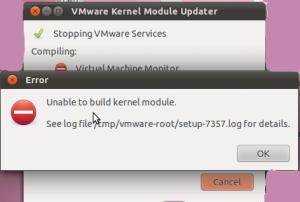Please Make Sure That The Kernel Module `vmmon Is Loaded.
Okay, that is known problem, kernel 4.14.15-1 have “retpoline” patchset applied. You either have to update kernel again (there should be 4.14.15-1.1 if I am not mistaken), or boot with “noretpoline” kernel flag. Stack Exchange Network. Stack Exchange network consists of 175 Q&A communities including Stack Overflow, the largest, most trusted online community for developers to learn, share their knowledge, and build their careers. CentOS VMware Player. No such file or directory. Please make sure the kernel module 'vmmon' is loaded. What could be the reason? Could you people suggest us on how to start the VMware player to open the virtual machine. Module vmmon not loaded Module vmnet loaded –.
After updating to Yosemite the only trouble I have is that VMWare Fusion (Professional Version 5.0.5 if that helps) fails to start showing following error:Could not open /dev/vmmon: No such file or directory.Please make surethat the kernel module `vmmon' is loaded.I've tried to google the issue but the only relevant thing found was:The Mac has a certain amount of devices it can register in the /dev/ directory., virtual devices like virtualization software and VPN clients also create devices in this directory quickly filling up the number to the limit. To solve this I went through my installed applications and removed every VPN client and VM software that I don’t require any longer and rebooted my machine.
After the reboot everything worked immediately.But even if this is true, I just can not get rid of my VPN client for example. So, I still have no idea what steps I should take to solve the issue. I'll be very much obliged for any hint how to fix this problem. In case anyone is running into this with VMware Fusion 6 on Yosemite. I had the same issue and it seems OS X only has a limited amount of major device numbers, which are used by many different device drivers. VMware Fusion tries to load its device drivers on app startup, so if every major device number is already occupied, the drivers won't start.A VMware employee presented some ways to find out which drivers are using major device numbers in this post:When I ran ls -l /dev/ grep '^c' sort -nk 5 I discovered that FUSE for OS X and Tuxera NTFS each appeared about 20 times. I don't know for sure how to stop/restart these drivers - I had the luck that FUSE for OS X asked to update itself after I opened its preferences pane, this caused all fuse devices to disappear.After this, VMware Fusion was able to its drivers and the VMs booted again.Edit: I had the same issue again after using a VeraCrypt mounted image.
This command line unloads the FUSE for OS X kernel extension if no filesystems are mounted:sudo kextunload -b com.github.osxfuse.filesystems.osxfusefs. I had this same problem running Mac OS Mojave 10.14, VMWare Fusion 11.0.0, Macbook Pro 2017, and could not get the issue resolved until I rebooted my Macbook Pro. After restarting it, I launched VMWare Fusion and was prompted to allow it to access some resources by going to System Preferences Security & Privacy, and selecting allow.Your Apple computer may ask you to allow VMWare Fusion specific access as soon you open the app. If that's the case, just allow it and your VM's will work just fine. Thanks to everyone above for contributing to the conversation and for the solutions being suggested above.

I downloaded the VMware S/W from official website and installed the same. When I try to run any virtual machine it shows errorCould not open /dev/vmmon: No such file or directory.

Please Make Sure That The Kernel Module Vmmon' Is Loaded. Centos
Please make sure that the kernel module `vmmon' is loadedand says failed to initialize.I tried solution and at the last command got the following error $ sudo mokutil -import MOK.derEFI variables are not supported on this system``Also I couldn't install the virtualbox as well, the error wasKernel driver not installed (rc=-1908).